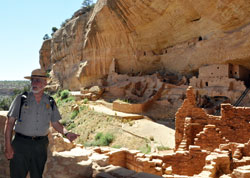Vacation / Travel Supplement
Cliffs and canyons: Mysterious Mesa Verde National Park captivates visitors

A National Park Service ranger explains how the early Pueblo Indians built homes among the treacherous cliffs, and lived there from about 1200 to 1300 then packed their belongings and migrated to unknown destinations. (Photo by Mary Ann Wyand)
By Mary Ann Wyand
SOUTHWESTERN COLORADO—Magical and mysterious, Mesa Verde National Park holds many secrets within its desolate, treacherous and windswept canyons.
It is considered to be holy burial ground by the Pueblo Indians, whose ancestors lived there on the mesa tops and later as cliff dwellers for 700 years from about 600 to 1300 then packed up their belongings and migrated to unknown destinations in the harsh wilderness of western North America.
“Mesa Verde,” which is Spanish for “green table,” is extremely rugged, mountainous land that is rich in history and thankfully protected by the U.S. Department of the Interior and the National Park Service.
Within its boundaries are more than 600 cliff dwellings among 4,700 known archeological sites.
Visitors to the national park can tour Cliff Palace, Balcony House, Long House, Spruce Tree House and Step House, all large, well-preserved cliff dwellings with from 40 to 150 rooms that are accessible by sometimes steep trails.
These hikes are rigorous in the often hot sun of the desert country, and some climbing is required on rustic ladders because the cliff dwellings are built high in the canyon walls.
But it is worth the effort to stand in the primitive dwellings hewn into the cliffs where Indian mothers gave birth, nursed their babies and lovingly cared for their children, hopefully keeping them safe from harm.
As I stood in a dwelling, I tried to imagine the women cooking simple meals of gritty, stone-ground cornbread for their families as well as climbing up and down the cliffs with small children secured close to their bodies.
The men must have worked hard to farm the meager soil and hunt for food. They left behind tiers of steps in the cliffs, which helped to protect the soil from wind and water erosion but offered very little space for growing corn.
I looked around these precarious living spaces with few sources of precious, life-giving water, and felt both admiration and wonder at the Pueblo Indians’ courage, determination, persistence and resilience as they struggled to survive each day so close to the treacherous cliff edges in all kinds of weather.
The ranger explained that larger rocks were often carved into hollows to collect rainwater.
The earliest Indians settled on the mesa tops, he said, where they grew corn for centuries.
About 100 years before they migrated to parts unknown, they built cliff dwellings in the craggy faces of the canyon walls, perhaps for safety or to clear more of the mesa tops for farming.
National Park Service rangers offer guided tours with educational, interpretative materials on a seasonal schedule determined by weather conditions. Parts of the park are closed during the winter months when only packs of wild horses cross this desolate wilderness.
The one-of-a-kind national park was established by President Theodore Roosevelt on June 29, 1906, to preserve its historical sites and protect its natural resources.
The mesas and canyons are starkly beautiful and fascinating to experience from a variety of vantage points and vistas throughout the park. It truly is sacred ground with countless burial sites over the centuries scattered among former living spaces.
Tourists often take photographs as Gustaf Nordenskiold did in 1891 when he explored some of the cliff dwellings. Later, the Swedish scientist wrote The Cliff Dwellers of the Mesa Verde, a detailed report of his archeological discoveries there.
Far View Lodge, located near the Visitors Center about 15 miles inside the park entrance, accepts reservations from mid-April through mid-October, but many visitors drive from nearby Durango, Colo., for day trips.
The park amenities include a cafeteria near the Chapin Mesa Museum, where visitors can buy breakfast, lunch and dinner.
Tourists should carry in water, which is a must for hikers anywhere, as well as trail mix and other snacks.
Park regulations require that whatever food and packaging is carried on the trails also must be carried out to respect and preserve the pristine nature of the remote terrain.
Breathtaking in its raw majesty, Mesa Verde National Park is a geological maze of panoramic scenery.
Beyond the land’s rare and unusual topography, the amazing cliff dwellings leave visitors wondering about the Native American people who somehow survived and raised families by carving out homes among the rocks of the desolate canyons.
(For more information about Mesa Verde National Park in southwestern Colorado, log on to www.visitmesaverde.com or www.nps.gov/meve.) †
